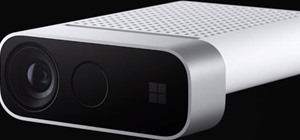
Welcome to the first annual Next Reality 30, our list of people who've made the biggest impact on the augmented reality space in the last 12 months — and what a 12-month roller-coaster ride it's been. Apple introduced ARKit-powered apps last fall, Google launched ARCore for Android soon after, Snapchat began monetizing AR, and the Magic Leap One headset finally came out. These are historic times.
If this is your first experience with tectonic technological disruption, you may not realize it, but we're living through an incredibly important moment in the history of computing. Just as many today can no longer remember a time before email, near-ubiquitous Wi-Fi, and smartphones, in just a few years, interacting with virtual objects anchored throughout the real world will become far more commonplace. As augmented reality moves beyond games and one-off app curios, it will become an essential part of how we interface with the digital world.
From the AR apps in your pocket to the cutting edge headsets that are gradually making their way into the marketplace, none of these milestones are occurring without a great deal of creativity and innovation forcefully pushing the boundaries of what's possible in AR.
While the rest of the tech industry focuses on the more obvious tech challenges and solutions in front of them using established platforms and concepts, a select group of innovators is looking deeper into the future to imagine what might be. But they're not just imagining the next generation of computing, they're creating it, even if, in some cases, the benefits and rewards of their work aren't readily apparent to most in the 2018 technology sphere.
The members of the NR30 all share three essential traits: courage, vision, and the ability to execute on that vision. It's these pioneers of immersive computing — whether you call it mixed reality, spatial computing, or augmented reality — that the NR30 is designed to recognize and celebrate for their risk-taking and massive bets on our collective future.
In a previous iteration, just about a year ago, we published the Next Reality 50. While it was important to recognize so many important individuals, the industry has rapidly matured in the past year, and we've realized that a new approach was needed.
It wasn't enough to simply highlight as many people working to push AR forward as possible. Instead, as the AR space is finally coming of age as a mainstream tool, it's clear that it's now important to narrow our focus and spotlight the efforts of those shaking up the field "right now," on a consistent basis, and in only the biggest and most far-reaching ways.
Over the next few weeks, we'll focus on what each NR30 person has meant to five different categories in the AR arena: hardware, software, investments, mobile, and industry influencers/community builders. Be on the lookout for those in-depth features coming soon, but first, let's dive into the full list of honorees.
1. Tim Cook, CEO – Apple
A large number of the people included in the NR30 mentioned ARKit as a significant turning point for AR in 2017 and 2018. Apple has a giant team working to make ARKit what it is, but its chief advocate is none other than Apple's CEO, Tim Cook. In 2018, Cook emerged as the number one cheerleader for mobile AR, backing his vision up with robust ARKit updates and the TrueDepth camera on the iPhone X that hints at big things for mobile AR at Apple in the future.
Of course, the Apple smartglasses rumors have only added to the excitement around what Apple could do to take AR fully mainstream via a wearable device. Whether that rumor is true or not, when the first publicly traded company to ever reach a 1 trillion dollar market capitalization decides to bet big on AR, led by Cook's vision, it's safe to say that AR is just at the beginning of its journey to mass commercialization.
2. Evan Spiegel, Co-Founder & CEO – Snap Inc.
Faced with constant copycat feature assaults from Facebook — the company Evan Spiegel turned away years ago despite Mark Zuckerberg's $3 billion offer — Snapchat is thriving. Today, what was once a playful high school kid-powered messaging app is now an AR powerhouse.

From Lenses, the mainstream-friendly, easy-to-grok smartphone camera filters that use AR to transform faces and environments, to Spectacles, the company's wearable camera (and possibly, in the future, AR smartglasses), Spiegel is already setting the stage for Snap Inc. to be viewed as one of the early pioneers of mobile AR.
Snap is also leading the charge in the realm of turning AR into a profit engine via its Shoppable AR platform, a tool that lets celebrities and brands deliver AR entertainment that leads to e-commerce opportunities with nothing more than a few taps on your smartphone screen.
And he's doing all this while navigating user gripes regarding Snapchat's frequently changing interface, stockholder doubts, and mounting competition from the likes of, well, everyone launching mobile AR apps via ARKit and ARCore. Nevertheless, Spiegel's company still does one important and incredibly difficult thing that many have struggled with: Snap makes AR fun.
3. Rony Abovitz, Founder & CEO – Magic Leap
In the first half of 2018, you could almost hear the collective sighs of exasperation coming from the tech community as Magic Leap kept the public waiting for the release of the Magic Leap One until the very end of the summer. But now that it's here, we can officially bring a close to all the speculation about one of the most hyped tech products since the iPhone, and the Segway before it. Now, it's time to see if the public (for now, mostly a small developer community) loves the product.
While the HoloLens has generally offered companies and developers a more enterprise-focused tool, the Magic Leap One hopes to become the go-to AR headset powering the entertainment industry, from gaming, via the forthcoming Dr. Grordbort's Invaders, to sports, through a partnership with the NBA, to movies (Legendary Entertainment is one of the company's earliest supporters).
But however the Magic Leap story shakes out in terms of adoption, after years of teasing, rumors, and billions in investment, Rony Abovitz has already accomplished something no one else has — he's planted the seeds of excitement and, dare we say, magic in the minds of the public in relation to AR. Whoever ultimately comes up with the leading wearable AR system, we'll all remember this moment as the period when the wearable AR device wars truly began. Today, it's Magic Leap versus HoloLens, and soon, Apple is expected to join the fray. Nevertheless, Abovitz, whether his company ultimately wins or not, gets credit for ramping up the competition and turning wearable AR into a true race to the top.
4. Tony Parisi, Global Head of AR/VR Brand Solutions – Unity
Visionary, passionate, and most of all, inspirational, Tony Parisi calls himself a "VR OG," and he's earned that title many times over. He was one of the earliest innovators working to make immersive computing tools and experiences available to everyone on the planet. Now, in his central role at Unity, his vision is finally coming to fruition, and the entire AR community is better for it.
Around this time last year, Unity announced major support for ARKit and ARCore, later introducing a multi-platform API called AR Foundation to aid in cross-platform development. And for those without robust coding skills, the company launched Project MARS (Mixed and Augmented Reality Studio). Finally, just a few months ago, Unity worked closely with Magic Leap to integrate its tools into the startup's new AR platform. And those are only a few of the highlights — Unity has been incredibly busy pushing AR forward through aggressive developer community outreach and internal technical development.
Although Parisi's official role involves leading Unity's AR and VR vision, he has slowly morphed into an overall evangelist for the entire immersive computing industry. Whether it's his insightful presentations at tech gatherings like AWE and other events, or his frequent and in-depth musings on the future of AR on his popular Medium feed and on Twitter, Parisi's steadying voice is exactly what AR needs to keep one eye on building the present, and one lens on the future.
"My original inspiration for getting into immersive tech was seeing the original Star Wars in the theatre as a kid," Parisi told Next Reality, recounting how Hollywood influenced his early vision of AR. "Even with the high-production AR and VR depictions we've seen in film over the last few decades, the scene of Princess Leia as a tabletop hologram remains the most inspiring depiction of augmented reality that I have ever seen."
5. Hugo Barra, VP of VR – Facebook/Oculus
Fresh from a stint in the mobile industry in China with Xiaomi, Hugo Barra is now back at Facebook, using what he's learned in Asia's incredibly competitive and fast-iterating market to help his old company figure out how to make immersive computing a part of everyone's social media experience.
In his new role, Barra is helping Facebook slowly merge and leverage its Oculus VR efforts with its AR efforts, which are mostly represented these days through the Facebook Messenger app, News Feed, and on Instagram.
In addition to bringing tools for personal engagement to its AR menu, Facebook has already worked on AR marketing efforts with the likes of Nike, Sephora, Asus, and KIA, and that's just the tip of the advertising (and revenue) AR iceberg. The company's AR Studio tools are already helping Facebook users interested in leveraging the power of AR. Through these immersive computing initiatives, Facebook is helping to inexorably sift AR into the mainstream bloodstream of billions of users around the planet.
After facing an incredibly tough year, as well as a recent hit to its stock price, Facebook is in the process of remaking itself once again, and Barra's leadership will be a significant part of the company's attempt to reframe what Facebook means to the world.
6. Alex Kipman, HoloLens Inventor – Microsoft
The inventor of the HoloLens and Microsoft's most enthusiastic and visionary purveyor of AR, or, as Microsoft prefers to call it, "mixed reality," Alex Kipman is a name you'd hear far more often if he weren't working within the massive ecosystem of the Redmond, Washington-based company.

While many have been eating up the buzz around Magic Leap, Kipman has quietly kept pushing the HoloLens forward with necessary updates looking toward a future when Microsoft's "mixed reality" platform coalesces into one cohesive immersive computing ecosystem. And even though the HoloLens is now a few years old, Kipman seems as excited as ever. That's probably because there's a new version of the HoloLens coming sometime in the next few months, and the AR industry is expecting big things from the update.
Currently, the HoloLens draws much of its attention from the enterprise space and developers, relatively far from the spotlight of other, more consumer-focused immersive computing initiatives. But Kipman's efforts haven't gone unnoticed or unrewarded. And when tales are told of the early days of AR, the developers who are passionately devoted to the HoloLens will tell future generations about how vital his device was to the space. Now and in the very near future, when the HoloLens 2.0 is released in 2019, Kipman remains an essential part of AR's still unfolding story.
7. Michael Abrash, Chief Scientist – Facebook Reality Labs
When Facebook holds its annual Oculus Connect conference, Michael Abrash is one of the lead voices the company uses to outline the future of immersive computing and what Facebook is doing to move it forward.
In addition to speaking at the company's annual Oculus Connect conference, in the waning months of 2017, Abrash penned an essay titled "Inventing the Future" detailing exactly how he sees the first pair of genuinely mainstream-friendly AR smartglasses becoming a reality. Along with inside looks at Oculus Research, the essay mapped out some of the hardware and software steps his team is undertaking to make such a product a reality. AR enthusiasts often talk about a future littered with AR smartglasses, but Abrash's detailed roadmap makes it seems closer than ever.
It's Abrash who in 2016 famously predicted that truly mainstream, small AR smartglasses won't be ready until at least 2022. Depending on where you stand on the topic, that statement is either incredibly optimistic or a bit bearish considering the rapid pace of technology. Nevertheless, his secretive work at Facebook Reality Labs may already be crafting his prediction into a tangible reality. Hopefully, Abrash will keep giving us updates, impressive demos and, ultimately, a pair of amazing AR smartglasses.
8. Imran Khan, Chief Strategy Officer – Snap Inc.
If the initial secret sauce of Snapchat was Spiegel's ability to attract young users, paving the way for the rest of the world to adopt the platform, Imran Khan is the person who is translating all that user attention into AR-powered marketing campaigns.
The best examples of this are embodied in Snap's new Shoppable AR initiative, which puts the power of AR in the hands of marketers looking to capture the fleeting attention spans of Snapchat users in ways that can be directly monetized. Additionally, the company is also allowing brands to harness the popularity of its Lenses and World Lenses tools by offering sponsored versions of the features.
Gradually, with every blockbuster film and new product campaign that harnesses the Snapchat platform, Khan is dragging some major non-tech companies into the world of immersive computing faster than anyone expected.
9. John Hanke, CEO – Niantic
Niantic has been operating for much longer than most realize, with founder John Hanke setting up the company within Google nearly a decade ago. Long-time Niantic users chuckle at all the focus on Niantic's role in popularizing Pokémon GO, because they know it was primarily made possible by the early work done on their true obsession, Ingress.
Today, Pokémon GO is used as shorthand for nearly anyone attempting to launch a successful mobile AR experience, whether it's a game, a navigation tool, or an educational experience. That impressive track record is probably why, when Lenovo recently came out with its AR experience, Hanke tossed some uncharacteristically outspoken critique at the project, calling the experience a "gimmick." In the same breath, he highlighted Pokémon GO's staying power and announced an expansion of the game into China.
But the company isn't resting on its past wins, as a Harry Potter AR game called "Harry Potter: Wizards Unite" is coming later this year, all while the company continues to enhance its first AR product, Ingress, to the delight of a small, but unusually dedicated fan base.
Hanke generally keeps a low profile, but he can't escape the fact that all his hard work in the shadow of the world's search giant is now paying off, and many are hoping to follow his lead.
10. Clay Bavor, VP of VR/AR – Google
He's central to Google's vision for AR and VR, which automatically means that every company that has ever done business with Google (read: most major companies) will likely be impacted by what Clay Bavor does with immersive computing under the search giant's banner.

It took Google some time to catch up to Apple's ARKit, but by the time the first quarter of 2018 arrived, the company finally released its competing AR toolkit called ARCore, gradually opening up the world's various Android handsets to the same kind of AR apps being offering on the iPhone.
In recent months, the company's progress with products like the Daydream View has been mixed in terms of adoption, but Google's rapid development and improvement of ARCore for Android smartphones underscores just how important AR is to the company. The number of ARCore apps is still fairly small, likely due in part to the fragmented nature of the Android ecosystem versus developer priorities, but Google's frequent updates are rapidly expanding the footprint of ARCore apps on Android smartphones.
Part of Bavor's mission is to make sure that none of Google's broad immersive computing vision falls behind the competition and, so far, he's doing a great job.
11. Bob Iger, CEO – Disney
While many Hollywood entertainment companies are adopting VR, AR has seen a slower path toward adoption outside of one-off promotions. But with Disney's Bob Iger now placing his bet on AR over VR, as detailed in a recent LA Times interview where he said "ordered his team not to even think about [VR]," Hollywood's attention is shifting toward the related but different discipline of crafting virtual experiences that merge with the real world.
What that means is that, instead of Disney theme parks and entertainment properties embracing VR in the same way as many other entertainment giants have in the last couple of years, Iger is planning on devoting the company's focus toward "high-tech augmented reality attractions." As the standard bearer of successful mainstream entertainment innovation outside of Silicon Valley, Iger's decision to focus on AR rather than VR is a significant market signal.
Thanks to Iger, it shouldn't be long before the rest of the entertainment industry begins to see Disney's efforts around the world as a reliable model for implementing mainstream AR entertainment experiences.
12. Lubomira Rochet, Chief Digital Officer – L'Oréal
We saw some of the first hints of what was possible with AR and the makeup industry via apps like Snapchat, with its face enhancing AR filters that can make nearly anyone look cute and youthful. But L'Oréal's Lubomira Rochet has moved much more aggressively than others in her efforts to make AR a fundamental part of the beauty industry.
The company's acquisition of AR startup Modiface this year has solidified L'Oréal's role as a leader of AR in the beauty space. Not long after that acquisition, the company paired up with Facebook to bring its face enhancing AR tools to millions of social media users.
The killer app for any new technology is utility, and Rochet is banking on the fact that most people will soon realize that, yes, AR is a powerful tool in the race to help consumers look their best.
13. Kyle Roche, General Manager – Amazon Sumerian
Over the years, Amazon has dominated the book industry, the retail industry, and recently the grocery space, so it should come as little surprise that the company also has its eye on AR. Internally, that effort is being led by Kyle Roche, who is helping the company Jeff Bezos built deliver new tools like Amazon Sumerian that promise to allow anyone to build AR and VR apps with little technical expertise.
Launched in late 2017, Amazon Sumerian moved from beta to full-fledged tool available to all just a few months ago. But instead of keeping the tool closed off within its massive platform, the tool supports WebVR, WebGL, iOS, Android, as well as the Oculus Rift and HTC Vive. The web-based tool has can also be used in conjunction with Amazon's text-to-speech tool Polly, AWS IoT (for internet of things devices), and Amazon Lex (for Alexa-style conversational interfaces).
It's still early days for Amazon Sumerian, but considering the company's incredibly broad product database, it could turn out to be a vital part of turning AR commerce into something used by most of the planet in the very near future. As that new reality rolls out, Roche will be in a lead position to help the company achieve its ambitious vision for AR.
14. Aleissia Laidacker, Interaction Lab Dir. – Magic Leap
While Magic Leap kept most of the public at bay, keeping its secrets wrapped up tight, Aleissia Laidacker took on the difficult task of not only working within the company to help build the product suite, but also reach out to the developer community in a way that made Magic Leap immediately more accessible, human, and fun.
Now that Magic Leap One is out in the world, Laidacker has been able to be a bit more open about how the company's Interaction Lab works, explaining the team's vision at some of the most prominent tech and gaming conferences, such as Siggraph and Gamescon. While Magic Leap CEO Rony Abovitz is stoking enthusiasm for the Magic Leap One with the general public, Laidacker is bringing that same message to the developer and general gaming community.
"The use of artificial intelligence," Laidacker told Next Reality when asked what current AR is missing. "I think this is something we'll see a lot more of in the coming years. A real focus on creating believable characters that not only look believable but that react and adapt to the environment around them."
15. Keiichi Matsuda, Creative Dir. & VP of Design – Leap Motion
What started as a cool art project turned into a touchstone for the entire AR industry in the way of imagining the future of immersive computing. Now Keiichi Matsuda's far out vision (the short film Hyper-Reality), which has inspired thousands working in the AR space, has landed him at one of the companies actually building a part of that vision.

Joining the Leap Motion team toward the end of 2017, Matsuda is charged with working within a team that is attempting to marry the sci-fi-infused imagery from Matsuda's imagination with the very real software, and now hardware (in the form of Project North Star), that the company hopes will be used by a wide range of AR players and new startups.
"When I started making my AR films, I didn't necessarily believe that AR would be the future," Matsuda told Next Reality, describing the moment he knew AR was the future. "It was really just a neat way for me to think about the relationship of technology and architecture. Then it became a filmic device, a neat way to comment on the way we use technology today. After a while though, I started to see it's transformative potential."
16. Julie Young, Co-Founder & CEO – SH//FT
One of the great things about the immersive computing space is that, because no rules have been established, the space is wide open to a range of voices and perspectives. But to avoid repeating some of the flawed patterns of Silicon Valley's past regarding company cultures and industry opportunities, more efforts are being made by industry experts like Julie Young, a Snap Inc. veteran, to ensure that diverse voices are well represented in the AR and VR space.
A former VR producer at the Emblematic Group, the company led by VR content pioneer Nonny de la Peña, she produced room-scale VR experiences including Out of Exile: In Daniel's Shoes and Across the Line. More recently, Young's work at SH//FT, in collaboration with Microsoft and its HoloLens device, is helping to highlight the full array of perspectives and skills involved in AR to the general public.
17. Paul Travers, Founder & CEO – Vuzix
If you look away from smartphones and devices like the HoloLens and Magic Leap, you soon realize that AR is mostly dominated by enterprise hardware makers like Vuzix. Guiding Vuzix's hardware efforts is Paul Travers, the company's founder and the visionary behind many of its products, with several decades of experience in the consumer electronics space.
The highlight of Vuzix's year is when the company showed off an Alexa-enabled version of its Vuzix Blade AR smartglasses, an extremely early look at what it's like to interact with smart assistants via an AR wearable. For now, the company appears focused on enterprise users, but the looks and ease of use delivered by the Vuzix Blade could change that in the near future.
Travers has been around for a long time, so we asked him if there were any underexposed leaders he'd add to any list honoring AR innovators. "Thomas Alt, founder and CEO of Metaio, which was acquired by Apple in May 2015," said Travers.
"Metaio was one of the leading computer vision and augmented reality technology providers worldwide. Metaio's vision was to teach smart devices to see, in a fast way, superimpose relevant information and make this base technology available to the masses. If you look at what Apple has done around ARKit it is clear they have executed on Metaio's (and Thomas's) long-term vision of superimposing information on smart devices and bringing it to the masses through smartphones."
18. Ralph Osterhout, Founder & CEO – ODG
While most of the AR smartglasses industry is focused on enterprise solutions, ODG is attempting to peer into the future by crafting devices that can work both on the factory floor and in your living room.
At the head of that effort is Ralph Osterhout, a man with so many patents under his belt over the last few decades that you'd think he'd be slowing down by now, but instead, he's pushing the company forward faster than ever.
In recent months, the company has shown off slick entertainment-oriented interfaces for its R-8 and R-9 AR smartglasses, partnered top-tier Japanese wireless company KDDI to help make AR smartglasses mainstream in Japan, and revealed its Smoke Assured Vision Enhanced Display (SAVED), an AR mask designed to help airplane pilots during emergency situations. Although ODG doesn't get the same kind of press as Apple, Google, and now Magic Leap, the company's slick design and increasingly impressive software can't be denied, and it's all happening under Osterhout's watch.
19. Tipatat Chennavasin, Co-Founder/Partner – Venture Reality Fund
There are investors, and there are tech evangelists, and then there's Tipatat Chennavasin, who is a dynamic combination of both. A frequent speaker at some of the leading AR and VR conferences and events, most recently at the 2018 AWE conference, he's not only injecting the AR space with startup backing, he's also one of AR's best new ambassadors for the uninitiated.
Chennavasin is a co-founder and general partner at the Venture Reality Fund, which raised a $50 million fund back in 2016. Last year, the firm secured additional funding from HP Tech Ventures and formed a partnership with Yahoo! Japan to accelerate the adoption of AR and VR technologies. More recently, in 2018, the Venture Reality Fund participated in an $8 million funding round for 8th Wall, an AR developer platform led by former Google & Facebook engineers.
Other investments made by the Venture Reality Fund in recent months include PLNAR (an AR measurement tool), Facemoji (Camera-driven avatars for live game streaming and video chat), and Virtualitics (data visualizations in augmented reality environments). The firm was also one of the three organizations (along with Super Ventures and the GFR Fund) that put together this year's Global Online Augmented Reality Pitch Event, an event designed to pair AR startups with seed or Series A investors.
If you happen upon his Twitter feed, you'll mostly see his constant stream of effusive AR and VR fan musings. But beyond the enthusiasm and cheery social media networking, very quietly, behind the scenes, he's working with his VC team to support a still very young AR space in need of the kind of funding and support the Venture Reality Fund was designed to provide.
20. Robert Sumner, Associate Dir. – Disney Research
Disney Research regularly posts experiments that astound, but some of the group's recent immersive computing work has been transcendent. One of the leaders within the group is Robert Sumner, who, while based in Zurich, Switzerland, is helping Disney change how the world interacts with reality.
Sumner has co-authored several publications for research into augmented reality innovations, such as AR face projection, and a mobile AR app that allows users to re-color paintings in AR.
The most recent Disney Research innovation, revealed earlier this year, involved intelligent AR characters that can interact with and react to real-world obstacles. Supported at the executive level by the afore-mentioned Bog Iger, Disney Research is poised to change the way we all experience our favorite characters and stories.
21. Jeff Powers, Co-Founder & CEO – Occipital
The end game for AR is mobile, not smartphone mobile, but, eventually, headworn mobile devices. Occipital, led by Jeff Powers, is locked in on the goal of helping to capture and track the real world to make it seamlessly interoperable with mobile AR applications. Powers isn't the only one working toward this goal, but he's one of the best.
Years ago, the company's first Kickstarter-funded initiative to provide a 3D sensor for iPhones was incredibly successful, ultimately raising $1.2 million. But now that ARKit is here, the company has begun to focus some of its efforts on utilizing that new AR toolkit. The most recent example of this is TapMeasure, a mobile AR app for measuring rooms released late last year. Occipital followed that up by acquiring 3D scanning company Paracosm.
"The introduction of scale accurate and robust AR frameworks like ARKit and ARCore, and importantly, the work going on behind the scenes to properly factory-calibrate devices for AR, is the biggest shift in the last year," Powers told Next Reality. "It's leading to a radical growth in AR developers, and I look forward to the first practical uses or AR that aren't predominantly a gimmick like most of what we've seen to date."
22. Joseph Mikhail, Chief Revenue Officer – Meta
His title at Meta makes Joe Mikhail sound like a buttoned-up, bottom line guy focused on keeping the lights on at the company, but he's not just a numbers guy. His passion for AR is apparent as soon as he begins talking to you about the space. It will take visionary developers and hardware makers to bring AR to its full potential, but none of it will start to take off until people like Mikhail harness their genuine excitement for AR into revenue that begins to make the rest of the world take notice.

This year, Meta reached a significant milestone by partnering with Dell. The longtime PC giant is the first authorized reseller of Meta 2 hardware and immediately lifted Meta's profile as a potential solution for business customers around the world. As someone who has been behind the scenes with Meta for some time, sitting on the company's Board of Directors as far back as 2015, his recent shift to the role of chief revenue officer puts an experienced operator (he's a veteran of Lenovo) with a deep understanding of Meta's roots on the leadership team. And he has quickly made an impression on his peers in the AR space, most recently delivering a stirring speech at AWE on the art of storytelling in AR.
"Minority Report," Mikhail answered when Next Reality asked which movie influenced his future vision of AR. "A decade ahead of the technology, potentially shaping our collective dream of what's possible."
23. Tom Emrich, Partner/Co-Producer – Super Ventures/AWE Conference
If you've been involved in AR for even a short time, you've probably heard of Tom Emrich; He's literally everywhere. Between his role at Super Ventures, searching for AR startups that can transform the world, and his tireless work at the annual AWE conference, Emrich lives and breathes AR, and if you follow him on social media or in the real world, you will, too.
During the most recent AWE conference, some estimates put the number of attendees at around 6,000, the largest ever for the still growing AR meetup of large and small companies in Silicon Valley. Initially launched with a relatively small (by Silicon Valley standards) $10 million fund, Super Ventures most recent investment in 2018 was in the UK-based Gravity Sketch, a startup focused on developing immersive 3D design software for designers in the film industries, fashion, and car industry.
"I started working with augmented reality back in 2009 when flip phones were still the most common devices in people's hands," Emrich told Next Reality while describing one of his first experiences with AR. "At the time, I was working as a product manager in publishing to 'save paper' with emerging tech like AR and so one of my first memorable experiences was Esquire magazine's AR cover with Robert Downey Jr. which was facilitated by a giant QR code triggered when you held up the cover to your web cam."
24. Peter Rojas, Partner – Betaworks Ventures
Even if you have no role in the tech industry, you've almost certainly read his work as one of the founders of Gizmodo and then Engadget. In the same way that he planted his flag early in a still unformed blog universe, Peter Rojas is now working to fund and support innovative AR startups in his new role as one of the space's leading venture capitalists.

This year, Rojas launched Visioncamp, a Betaworks startup accelerator offering funding for new companies working with augmented reality, computer vision, and "camera-first products and services." Among Betaworks' most notable AR investments are 8th Wall, Camera IQ, and Streem.
As someone who has been involved with translating tech into mainstream consumable concepts for many years, we were curious as to what his favorite TV science fiction take on AR has been. "The 'Men Against Fire' episode of Black Mirror," said Rojas. "[It] does a good job of highlighting some of the ethically murky areas we are heading into when it comes to AR and how it could (and surely will) be used to manipulate people."
25. Alban Denoyel, Co-Founder & CEO – Sketchfab
Serving the creators of AR and VR experiences is a tough job, but Alban Denoyel has turned his practice of developing the Sketchfab community into an art form, mixing hands-on user passion with the kind of backend business stewardship artists and developers need in these early days of AR growth.
Using Sketchfab, users can access over 2 million 3D models, some for free, others for a fee. Those models can then be easily integrated into AR and VR applications and experiences. Despite the company's small size, it has been on a tear in the past 12 months, launching a professional store for creators, adding ARCore functionality to its mobile app, and integrating its tools directly into Facebook via its Download API.
"[There's] too much focus on native solutions," Denoyel told Next Reality regarding one of the things the AR space could be doing better. "[Because of this] progress on web solutions is too slow!"
26. Graham Roberts, Dir. Of Immersive Platforms – The New York Times
The New York Times is the company most referenced when tech experts frame the story of old-school media working (often without success) to adopt the tools of the 21st century. Luckily for the Times, Graham Roberts has been expertly steering the "Gray Lady" into the rough and mostly unexplored arena of AR news reporting.
By now, you probably already know about the paper's involvement with the launch of the Magic Leap One, featured as the only made-for-AR news app during the device's launch. But before that, the paper was already aggressively rolling out numerous long-form AR news features via its mobile app. So far, the media giant has used AR to dive deeper into stories about natural disasters, rock legends like David Bowie, and historical events like the Olympics.
"Seeing this art project (featuring photos with smartphones from the hands of models), [I realized] how dumb and inhuman phones are," Roberts told Next Reality when asked when he knew AR was the future.
27. Gordon Meyer, VP of Product & Marketing – Lampix
Over the course of the past year, there have been a number of VR professionals moving over to the AR side, and Gordon Meyer, previously of YouVisit, is one of those executives. Although he's been in the space for a relatively short time, he has quickly ramped up awareness for Lampix and is helping pioneer the idea of marrying AR with blockchain technology.

Instead of focusing on headworn devices or AR via smartphones, Lampix want to turn everyday objects, like lamps and ceiling fixtures found in nearly every room on the planet, into AR devices. The company's flagship device contains a high definition projector, a built-in speaker, and depth-sensing camera that allows users to directly interact with imagery projected onto tabletops. To help drive its efforts, the company launched an ICO (initial coin offering) to raise funds and inject itself into the cryptocurrency space. Ultimately, the company wants to use blockchain technology to facilitate a vast image database.
"For VR it was Tilt Brush," Meyer told Next Reality, detailing his first experience with immersive computing. "As a formally trained artist it was a truly groundbreaking experience. I truly fell in love with the medium through that experience. For AR, it really was Snapchat Lenses, which I think has been most people's introduction to augmented reality."
28. Matt Miesnieks, Co-Founder & CEO – 6D.Ai
Many in the AR space think that the AR cloud could be the holy grail of supercharging AR adoption, and Matt Miesnieks and his team at 6D.ai are trying to be one of the first companies to provide a seamless solution to address this dynamic. Backed by some of the most prominent investors in Silicon Valley, Miesnieks is moving fast to take 6D.ai from beta product to full-fledged game changer.
What 6D.ai does is enable persistent, shared AR experiences with just a regular smartphone camera. The company's demos showing off virtual object occlusion, as well as its focus on the AR cloud makes 6D.ai one of the most exciting bleeding AR startups we've seen.
"Concept videos that don't show the actual UX in an unstaged setting," Miesnieks told Next Reality while explaining one of his pet peeves about new software in the AR space. "[Or the demo videos] are ambiguous about what it's running on. Subtract more points if the video contains a cliché dragon or a dinosaur."
29. Kevin Zhong, Founder & CEO – DreamWorld
Not every path to success is perfect, but the point is to keep on trying, and that's what DreamWorld founder Kevin Zhong is doing as he works to put his DreamGlass mobile AR headset in the hands of the world. He's facing significant challenges on all fronts but, so far, it looks like the big players may need to watch out because he is making a lot of progress with a tiny team and a lot of ambition.
At the latest AWE conference, Zhong demoed the DreamGlass headset and showed off just how well it works with existing smartphones. Although not on the same level as the HoloLens or Magic Leap, the device's headworn dynamic paired with the mobile aspect of DreamGlass, which is cheaper than anything similar on the market, gives this startup a fighting chance in the coming year.
"Robert Downey Jr., and I am not joking," Zhong told Next Reality when asked who he'd put on this list. "The Iron Man series greatly helped the AR industry. It told the mainstream what AR is and what AR is capable of. Countless AR companies use Iron Man for their PR when they launch their products, or deliver their pitches to VCs. I hope one day we can really change the world and everyone can be like Iron Man."
30. Stuart Campbell (Sutu), Co-Founder/Creative Dir. – EyeJack
The video game and VR communities have their artists, so it's only natural that the AR space would have its own art-focused creators, and Stuart Campbell is leading that charge. If you're not an AR gamer, or a still have trouble figuring out how iPhone/Android AR measuring and map tools work, how about just looking over there at that framed illustration and watching as a beautiful creature crawls out of it? That's the kind visual adventure and artistry Campbell brought to the AR space with his Eyejack app, and he's just getting started.
Campbell followed the initial release up with the EyeJack Creator app. That tool allows anyone to take videos or gifs and produce the same kind of real-world art-triggered AR animations as seen in the original EyeJack mobile app.
"I did a little AR eyeball sticker a few years back, where a little laughing worm pops out of an eyeball," Campbell says, telling Next Reality how and when he knew AR was the future. "I gave it to some kids and they immediately went and stuck it on their dog's butt. That was a pivotal moment. They went and stuck it on their dad's chest when he was sleeping, and then they stuck it over each [other's] eyes. Those kids were having so much fun with that one sticker."
Stay Tuned for More NR30 Insights
Congratulations to everyone on the 2018 edition of the NR30. Over the course of the next year, the story of AR will change, but the brilliant insights and inspiring efforts of everyone on the NR30 will live forever. Check back here next week as we begin delving deeper into the individual stories of everyone mentioned in the NR30, starting with the leading investors in the AR space!
Just updated your iPhone? You'll find new features for Podcasts, News, Books, and TV, as well as important security improvements and fresh wallpapers. Find out what's new and changed on your iPhone with the iOS 17.5 update.























Be the First to Comment
Share Your Thoughts